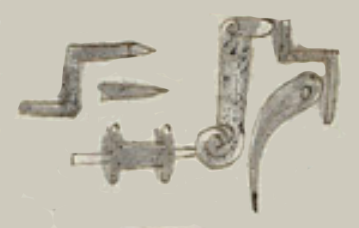tepoztli tornos (CST28)
This painting of the simplex glyph for the expression tepuztli tornos (iron wheels or reels for working with silk) shows a group of dark gray iron tools. Perhaps only one is a reel, and other pieces appear to be handles for turning reels.
Stephanie Wood
The cost of forging iron tools for working with silk was doable given the high profits from silk–probably at least until competition arose with the imports brought to New Spain from Asia on the Manila galleons. For more on the Codex Sierra, see Kevin Terraciano’s study (2021), especially page 152, for a translation of the Nahuatl text describing these tools, and 77-83 for information about the silk industry.
Stephanie Wood
1550–1564
Jeff Haskett-Wood
seda, economía, tecnología, herramientas, metales, hierro, carretes, bobinas
The signage for this museum piece of sixteenth-century forged iron describes it as an espetera. It vaguely resembles some of the iron in the Códice Sierra-Texupan, above. Museum of the city of Guadalajara. Photo by S. Wood, 15 April 2025.

tepoz(tli), herel, iron, https://nahuatl.wired-humanities.org/content/tepoztli
torno, here, an iron wheel for spinning (or reeling) silk, https://nahuatl.wired-humanities.org/content/torno
tornos de hierro
Stephanie Wood
Códice Sierra-Texupan, plate 28, page dated 1559. Origin: Santa Catalina Texupan, Mixteca Alta, State of Oaxaca. Kevin Terraciano has published an outstanding study of this manuscript (Codex Sierra, 2021), and in his book he refers to alphabetic and “pictorial” writing, not hieroglyphic writing. We are still counting some of the imagery from this source as hieroglyphic writing, but we are also including examples of “iconography” where the images verge on European style illustrations or scenes showing activities. We have this iconography category so that such images can be fruitfully compared with hieroglyphs. Hieroglyphic writing was evolving as a result of the influence of European illustrations, and even alphabetic writing impacted it.
https://bidilaf.buap.mx/objeto.xql?id=48281&busqueda=Texupan&action=search
The Biblioteca Digital Lafragua of the Biblioteca Histórica José María Lafragua in Puebla, Mexico, publishes this Códice Sierra-Texupan, 1550–1564 (62pp., 30.7 x 21.8 cm.), referring to it as being in the “Public Domain.” This image is published here under a Creative Commons license, asking that you cite the Biblioteca Digital Lafragua and this Visual Lexicon of Aztec Hieroglyphs.








